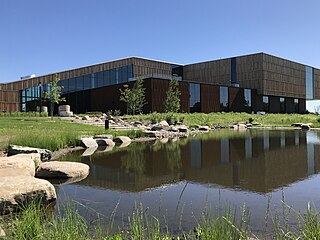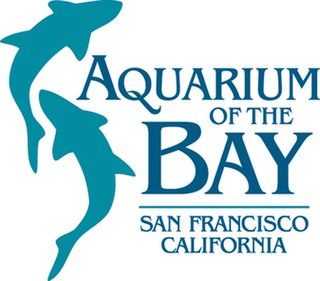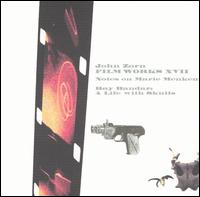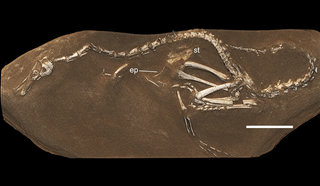Related Research Articles

The La Brea Tar Pits is an active paleontological research site in urban Los Angeles. Hancock Park was formed around a group of tar pits where natural asphalt has seeped up from the ground for tens of thousands of years. Over many centuries, the bones of trapped animals have been preserved. The George C. Page Museum is dedicated to researching the tar pits and displaying specimens from the animals that died there. La Brea Tar Pits is a registered National Natural Landmark.

The dire wolf is an extinct canine. The dire wolf lived in the Americas during the Late Pleistocene and Early Holocene epochs. The species was named in 1858, four years after the first specimen had been found. Two subspecies are recognized: Aenocyon dirus guildayi and Aenocyon dirus dirus. The largest collection of its fossils has been obtained from the Rancho La Brea Tar Pits in Los Angeles.

The California Academy of Sciences is a research institute and natural history museum in San Francisco, California, that is among the largest museums of natural history in the world, housing over 46 million specimens. The academy began in 1853 as a learned society and still carries out a large amount of original research. The institution is located at the Golden Gate Park in San Francisco.

The Buffalo Museum of Science is a science museum located at Martin Luther King Jr. Park in Buffalo, New York, United States, northeast of the downtown district, near the Kensington Expressway. The historic building was designed by August Esenwein and James A. Johnson and opened on January 19, 1929. It gave a permanent home to the exhibits that started to be collected by the Buffalo Young Men's Association, which had passed them to its 1861 creation, the Buffalo Natural History Society, with George W. Clinton chosen as the Society's first president.

Rollo Howard Beck was an American ornithologist, bird collector for museums, and explorer. Beck's petrel and three taxa of reptiles are named after him, including a subspecies of Galápagos tortoise, Chelonoidis nigra becki from Volcán Wolf. A paper by Fellers examines all the known taxa named for Beck. Beck was recognized for his extraordinary ability as a field worker by Robert Cushman Murphy as being "in a class by himself," and by University of California at Berkeley professor of zoology Frank Pitelka as "the field worker" of his generation.

Deinocheirus is a genus of large ornithomimosaur that lived during the Late Cretaceous around 70 million years ago. In 1965, a pair of large arms, shoulder girdles, and a few other bones of a new dinosaur were first discovered in the Nemegt Formation of Mongolia. In 1970, this specimen became the holotype of the only species within the genus, Deinocheirus mirificus; the genus name is Greek for "horrible hand". No further remains were discovered for almost fifty years, and its nature remained a mystery. Two more complete specimens were described in 2014, which shed light on many aspects of the animal. Parts of these new specimens had been looted from Mongolia some years before, but were repatriated in 2014.

The Denver Museum of Nature & Science is a municipal natural history and science museum in Denver, Colorado. It is a resource for informal science education in the Rocky Mountain region. A variety of exhibitions, programs, and activities help museum visitors learn about the natural history of Colorado, Earth, and the universe. The 716,000-square-foot (66,519 m2) building houses more than one million objects in its collections including natural history and anthropological materials, as well as archival and library resources.

Thalassiodracon (tha-LAS-ee-o-DRAY-kon) is an extinct genus of plesiosauroid from the Pliosauridae that was alive during the Late Triassic-Early Jurassic (Rhaetian-Hettangian) and is known exclusively from the Lower Lias of England. The type and only species, is Thalassiodracon (Plesiosaurus) hawkinsi.

Sue is the nickname given to FMNH PR 2081, which is one of the largest, most extensive, and best preserved Tyrannosaurus rex specimens ever found, at over 90 percent recovered by bulk. FMNH PR 2081 was discovered on August 12, 1990, by American explorer and fossil collector Sue Hendrickson, and was named after her.

The Bell Museum, formerly known as the James Ford Bell Museum of Natural History, is located at the University of Minnesota's Saint Paul campus. The museum's current location on the Saint Paul campus opened in 2018. The Minnesota wildlife dioramas showcase animal specimens from around the world. The museum also houses the digital Whitney and Elizabeth MacMillan Planetarium. The museum is part of the university's College of Food, Agricultural and Natural Resource Sciences. The museum's former location on University of Minnesota's Minneapolis campus closed in January 2017.

Aquarium of the Bay is a public aquarium located at The Embarcadero and Beach Street, at the edge of Pier 39 in San Francisco, California. The aquarium is focused on local aquatic animals from the San Francisco Bay and neighboring rivers and watersheds as far as the Sierra Mountains. Since 2005 the Aquarium has focused its mission on enabling ocean conservation and climate action both locally and globally. It is one of seven institutions under parent company Bay Ecotarium, the largest watershed conservation organization in the Bay Area
Griff Williams, is an American painter, publisher, art instructor, filmmaker, and gallerist. He owns Gallery 16 art gallery. His paintings have been exhibited in galleries and museums worldwide, including San Diego Museum of Art, Orange County Museum of Art, Crocker Art Museum in Sacramento, New Langton Arts, Andrea Schwartz Gallery and Stephen Wirtz Gallery, the San Jose Museum of Art, and the Eli Ridgeway Gallery. His work has been reviewed in Art in America, Frieze, Flash Art, SFAQ, and Artnet.com.

Kolponomos is an extinct genus of carnivoran mammal that existed in the Late Arikareean North American Land Mammal Age, early Miocene epoch, about 20 million years ago. It was likely a marine mammal. The genus was erected in 1960 by Ruben A. Stirton, a paleontologist at the University of California Museum of Paleontology, Berkeley, for the species K. clallamensis, on the basis of a partial skull and jaw found on the Olympic Peninsula. At the time, Stirton questionably assigned it to Procyonidae, its systematic position remained problematic until the discovery of more fossils including a nearly complete cranium from the original locality of K. clallamensis which helped identify it as part of the group from which pinnipeds evolved.

Filmworks XVII: Notes on Marie Menken/Ray Bandar: A Life with Skulls features scores by John Zorn for two documentary films. The album was released on Zorn's own label, Tzadik Records, in 2006 and contains music that Zorn wrote and recorded for, Notes on Marie Menken (2006), directed by Martina Kudláček and a percussion score for Ray Bandar: A Life with Skulls directed by Beth Cataldo.

The Paleozoological Museum of China is a museum in Beijing, China. The same building also houses the Institute of Vertebrate Paleontology and Paleoanthropology of the Chinese Academy of Sciences. The museum contains exhibition halls with specimens aimed at the public, while the rest of the building is used for research purposes.
Cosmic Ray is a 1962 American experimental short film directed by Bruce Conner. With both found footage and original material, it features images of countdown leader, a nude woman dancing, a Mickey Mouse cartoon, and military exercises. It is soundtracked by a performance of Ray Charles's "What'd I Say" and has been recognized as the first music video.

The Museum of Osteology, located in Oklahoma City, Oklahoma, U.S., is a private museum devoted to the study of bones and skeletons (osteology). This museum displays over 450 skeletons of animal species from all over the world. With another 7,000 specimens as part of the collection, but not on display, this is the largest privately held collection of osteological specimens in the world. The museum is an entity of its parent company, Skulls Unlimited International.

Bone Clones, Inc. manufactures, distributes, and sells osteological reproductions of human and animal bones. Located in Chatsworth, California, Bone Clones provides these reproductions to museums, universities, medical schools, and other educational institutions.

Halszkaraptorinae is a basal ("primitive") subfamily of Dromaeosauridae that includes the enigmatic genera Halszkaraptor, Natovenator, Mahakala, and Hulsanpes. Halszkaraptorines are definitively known only from Late Cretaceous strata in Asia, specifically in Mongolia. It is debated among researchers whether the group had a semiaquatic lifestyle.

The Dunedin Museum of Natural Mystery is a private museum of bones, bone art, ethnographic artifacts, and assorted curios in Dunedin, New Zealand. Created by mural artist and sculptor Bruce Mahalski, in his Royal Terrace residence, it opened to the public in March 2018.
References
- 1 2 Yollin, Patricia (2007-01-20). "The Bone Collector". San Francisco Chronicle. Retrieved 2023-01-16.
- 1 2 Cataldo, Beth (2017-08-17). "Ray Bandar: A Life with Skulls" . Retrieved 2023-01-16.
- ↑ Wong, Kathleen M. (Spring 2002). "A Man for All Skulls article on Bandar's work". California Wild. California Academy of Sciences. Retrieved 2023-01-16.
- ↑ Dowd, Katie (2018-03-01). "Ray 'Bones' Bandar's collection of 6,000 skulls gets new home in San Francisco". SF Gate. Retrieved 2023-01-16.
- ↑ Gereben, Janos. "Skulls head nifty Academy of Sciences show". San Francisco Examiner. The San Francisco Examiner. Retrieved November 27, 2014.
- ↑ Harmanci, Reyhan (April 26, 2007). "REP PICKS". SFGate. Retrieved 2017-12-24.